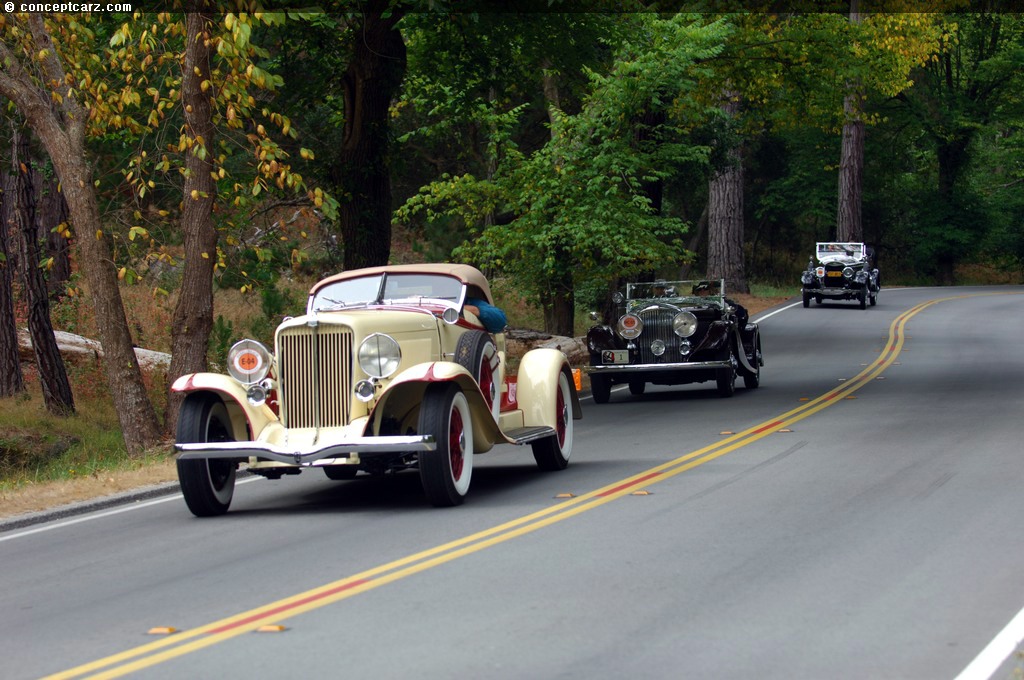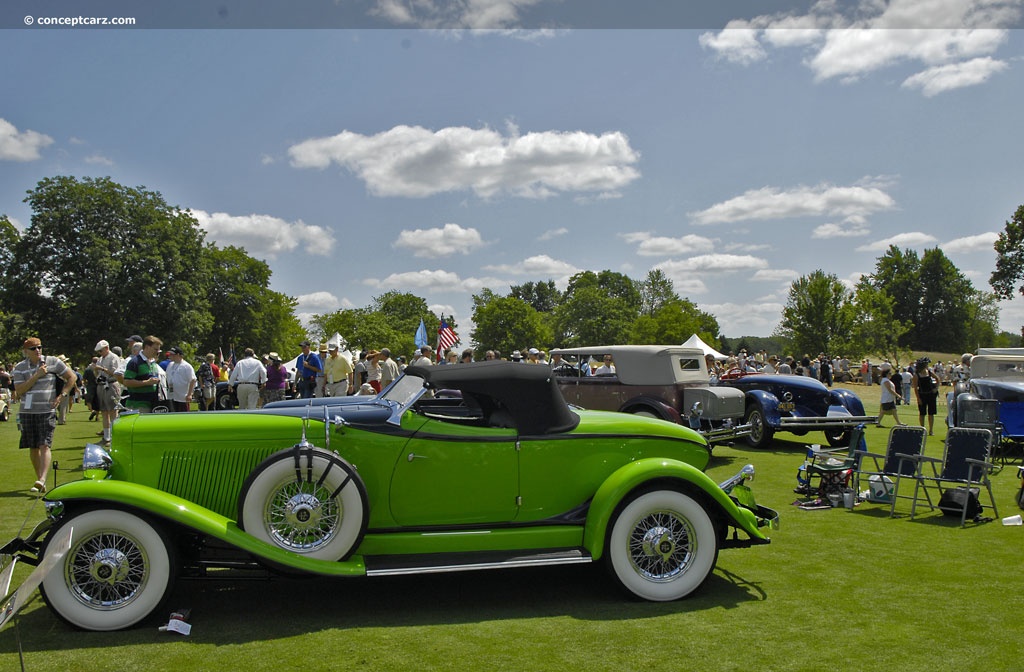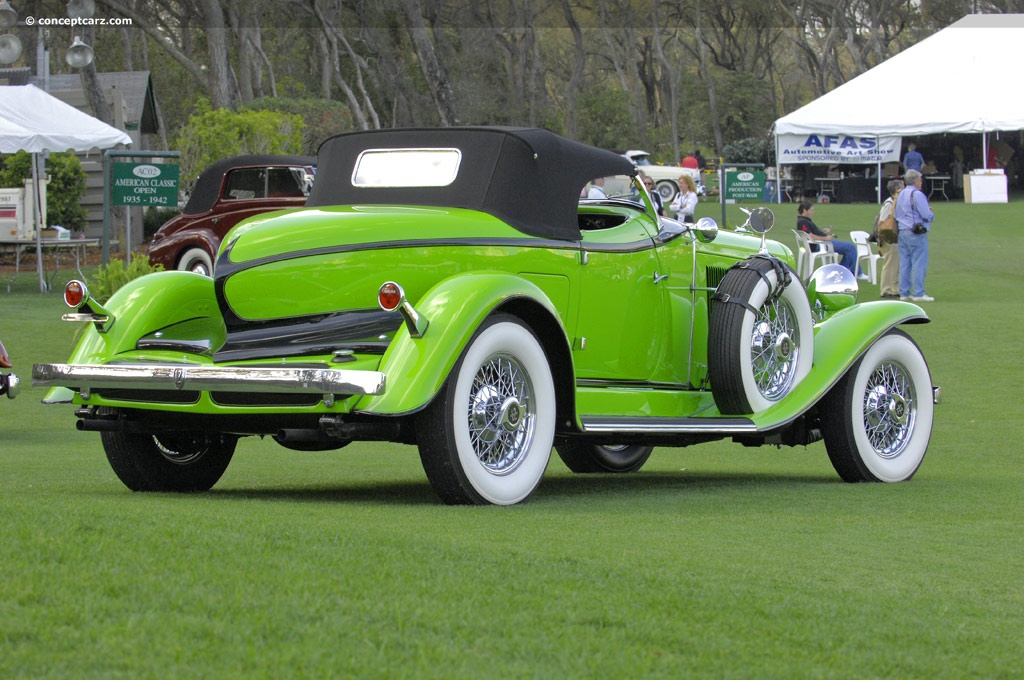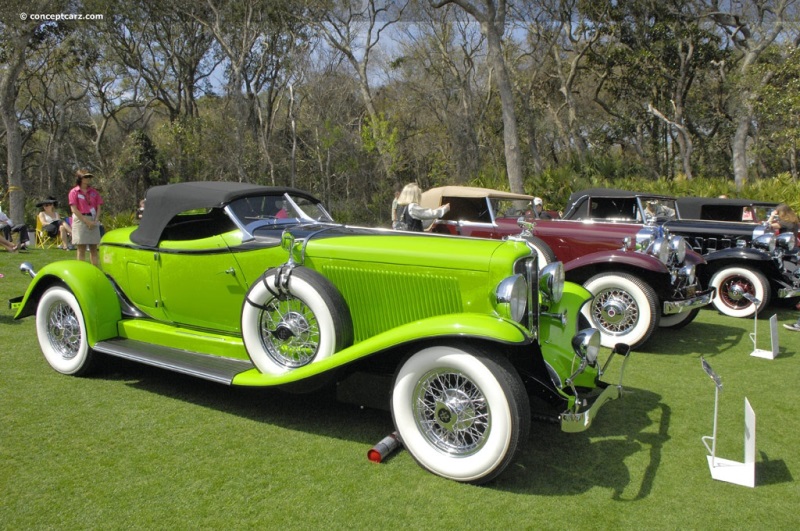Rooted in the Eckhart Carriage Company, established during 1874 by Charles Eckhart, the Auburn Company of Indiana produced single and twin-cylinder models during its early years of production through 1909. The first of the fours were introduced in 1909, and they would become the foundation for the new models going forward. During the Twenties, the leadership of Errett Lobban Cord saved the struggling and underperforming company and helped it become one of America's great marques of the 20th century. One of its most spectacular products was the Al Leamy-styled Boat-tail Speedster, which was a new introduction to Auburn's eight-cylinder range for 1928. The racy bodywork featured a dramatic tapering rear end and angled doors, and was advertised as 'the biggest package in the world for the price.' It sold for under $2,000 but offered a remarkable top speed of 100 mph, thanks to special chassis and engine modifications unique to this model. 
Speedster
View info and historyIn 1926, Cord purchased Duesenberg Corporation, famous for its racing cars, and used it as the launching platform for a line of high-priced luxury vehicles. E.L. Cord cultivated the Auburn company around a performance image, reinforced by several speed and distance trial runs. Driver Wade Morton clocked 108.46 mph on a measured mile at Daytona Beach and later covered 2,033 miles in 24 hours for a record 84.7-mph average speed at Atlantic City. Morton also set a new record at the challenging Pikes Peak hillclimb. Auburn closed out the 1920s by offering several engine options led by the 120 or so-called 'Big Eight,' name for the horsepower rating of its 268 cu. in. inline eight-cylinder engine. The 120 was available in several different body styles, drawn by Alan Leamy and reminiscent of the creations of California coachbuilder Murphy. A subtle beltline reveal molding flowed gracefully into the hoodline, accentuating the popular two-tone color schemes. Mechanical sophistication included a Bijur centralized chassis lubrication system, hydraulic shock absorbers, and Lockheed hydraulic brakes at all four wheels.Affordability, mechanical sophistication, modern and attractive body designs, and an enviable performance record contributed to Auburn's record sales levels for 1929 and helped Auburn meet the challenges of the looming Great Depression. Now that he had successfully launched his mighty Duesenberg Model J and the Cord L-29 was introduced, E.L. Cord gathered together all of his various companies in June under the umbrella of the Cord Corporation. In January 1929, E.L. Cord acquired Central Manufacturing in Connersville, Indiana, to increase production capabilities. Cord facilities now made up over 1.5 million square feet of factory floor space, a 900-foot-long assembly line, 20 modern buildings with a total capacity of 400 bodies, and 250 finished cars per day.
Speedster
View info and historyIn a short period of time, E.L. Cord had saved the struggling Auburn Company, and within five years, had increased its business by an unbelievable 1,300-percent. The 1929 net profit for Auburn would be an impressive 3.6 million. Sales fell during the immediate years of the Great Depression, but they more than doubled for 1931, and there were approximately a thousand new dealerships that had abandoned other marques to join Auburn. Auburn produced 23,509 vehicles in 1929, followed by 12,985 in 1930, 34,228 in 1931, and 11,145 in 1932. Sales would continue to decline, with 5,038 produced in 1933, increasing slightly to 7,770 units in 1934, before falling to 6,316 in 1935. In 1936, its final year of production, the company produced 1,263 vehicles. All-new styling was introduced by Leamy in 1931, and the public reaction was favorable, with over 4,000 orders taken at the New York Auto Show along. Few changes were made for 1932, although the most important was the adoption of the Columbia two-speed rear axle as standard equipment on all models. The Auburn vehicles were built on the first center X-bracing platform ever used by a rear-wheel-drive vehicle, with semi-elliptic suspension front and rear, Lovejoy hydraulic shock absorbers, and the L.G.S. Free Wheeling unit. The big news for 1932 was the company's new twelve-cylinder model priced at under a thousand dollars. It was, perhaps, the least expensive twelve-cylinder model ever marketed. The Auburn Twelve was produced for only two seasons, 1932 and 1933, with unsold cars retitled and sold into the 1934 model year.
Speedster
View info and historyAuburn's model lineup for 1932 included the Model 8-100 and the 12-160. The addition of the Dual Ratio rear axle resulted in an 'A' at the end of the model name (8-100A and 12-160A, respectively). The Model 8-100 rested on a 127-inch wheelbase platform and was priced at $675 to $845. Body styles included a coupe, brougham, sedan, phaeton, cabriolet, and speedster. A seven-passenger sedan on a generous 136-inch wheelbase was available, with prices beginning at $875. The Dual Ratio rear axle added approximately $150 to the base price. The 268.8 cubic-inch eight-cylinder engine by Lycoming produced 100 horsepower and was backed by a free-wheeling three-speed manual transmission. The Columbia Dual Ratio two-speed rear axle was optional and four-wheel drum brakes provided the stopping power. The range-topping Model 12-160 came powered by a 391.6 cubic-inch twelve-cylinder engine by Lycoming, designed by chief engineer George Kublin, with a narrow 45-degree 'vee' and fitted with a single Updraft carburetor. It had a 3-1/8-inch bore and a 4-1/4-inch stroke and four main bearings supported the crankshaft. A single camshaft was located in the engine's V, allowing the valves' horizontally located stems to be managed directly by rocker arms riding on the cam. The valves were enclosed in separate castings that could be removed without disturbing the cylinder heads, allowing for easy servicing. The combustion chambers were nearly vertical pockets. The engine was smaller than its competitors but no less powerful, in fact, it was the highest specific output per cubic inch displacement of any of Detroit's multi-cylinder engines of the day. The 160-horsepower engine was paired with a three-speed manual transmission, with Auburn's Dual-Ratio rear axle standard on Custom models. This Dual-Ratio axle allowed the car to be driven either in high-gear ratios for open country roads or in a lower ratio for city driving. The four-wheel internally-expanding Lockheed drum brakes took full advantage of Auburn's reinforced X-braced frame with additional front members. The suspension used semi-elliptical leaf springs all round. With prices starting at $1,425, the Auburn Twelve was less than half the price of a comparable Cadillac V-8 and more than $2,000 below a V-12. Cadillac's V-12 produced 135 brake horsepower and even the Cadillac V16 with its 452 cubic-inch displacement size had only five more horsepower than Auburn's Twelve. The affordability, however, may have been detrimental to the vehicle's sales, as buyers believed the cost was reflective of the build quality. Auburn was doing just what it had always done - offering its customers a great bargain for the money. To help endorse and promote the vehicle's performance, Auburn entered the V-12 in a number of speed record runs by factory driver Eddie Miller, who set 31 American stock car speed records at Muroc Dry Lake in December 1932 (in a 12-160 Speedster) in trials observed by the AAA, including covering 500 miles at an average of 113.57 mph, which was faster than Fred Frame's winning speed at the Indianapolis 500 that year. 
Speedster
View info and historyAs the Depression deepened, car sales continued to fall. During the two-and-a-half years of Auburn Twelve sales, approximately 2,250 examples were built in six body styles. For 1934, the Auburn lineup was restyled by Al Leamy, and after the updates were not well received, by mid-1934, the assembly lines were halted so that the much improved, face-lifted 1935 model could be rushed into production. Leamy would leave Auburn in 1934, saddled with the undeserved responsibility for the company's disappointing sales figures. Designer Gordon Buehrig was allotted a $50,000 budget to improve the styling, and he succeeded with semi-pontoon front fenders, an enlarged hood, and an attractive grille. Auburn sales brochures declared the latest Buehrig design as being 'Exclusive-Distinctive-Individual.' Performance and handling were improved thanks to a reduction of unsprung weight, a lowered center of gravity, and lower seat placement. Despite the attractive styling, great performance, and bargain pricing, Auburn was unable to combat the effects of the Great Depression, management turmoil, and E.L. Cord's complex business affairs. By 1937, Cord's empire had ceased production and one of the greatest chapters in automotive history had come to an end.
by Daniel Vaughan | May 2022

Speedster
View info and history

Speedster
View info and history

Speedster
View info and history

Speedster
View info and history
by Daniel Vaughan | May 2022
Related Reading : Auburn 12 History
At the tender age of fifteen, Errett Lobban Cord, commonly known as E.L. Cord, left school in pursuit of a job as a car salesman. After a successful stint in that profession, he began working as a mechanic in a service station located in Los Angeles. This led to modifying his Model Ts to include bodywork and engine modifications. He later moved to Chicago, where he went back to selling vehicles.....
Continue Reading >>
Continue Reading >>
Related Reading : Auburn 12 History
An exceptional value for their day, the Auburn was the least expensive marque in the Cord Empire that also comprised Duesenberg. Priced at %241,250, the Auburn was a spectacular value for a twelve-cylinder automobile. From 1927 to 1938 the AuburnCordDuesenberg Company manufactured hand-built custom vehicles of the highest quality in Auburn Indiana. Rated at 160 horsepower, the 1932 Auburn 12-160A....
Continue Reading >>
Continue Reading >>
Similar Automakers
1932 Auburn 12-160 Vehicle Profiles
Recent Vehicle Additions
Performance and Specification Comparison
Price Comparison
$675 - $875
$805 - $1,005
$1,105 - $1,295
12-One Sixty Specification Comparison by Year
Year
Production
Wheelbase
Engine
Prices
Related Automotive News

Gooding & Company Proudly Presents the Tony Vincent Estate Collection for its Pebble Beach Auctions
The Estate Collection of the late Tony Vincent features Classic Era icons, including a 1937 Mercedes-Benz 540 K Sport Cabriolet A, a 1934 Rolls-Royce Phantom II Continental Streamlined Saloon, and a 1939 Delage D8-120 Cabriolet Grand Luxe.
Leading...

Trump Charlotte Concours d'Elegance
The third annual Trump National Concours dElegance was held near the shores of Lake Norman on the nationally ranked and world-renowned Trump National Golf Club-Charlotte. The location has been named one of the most spectacular and exciting courses...

Auburn Is 'The Amelia's' Honored Classic In 2018
Auburns fabled boattail speedster is the car everyone pictures when the classic Indiana marque is mentioned. Only in the Jazz Age lubricated by the social privations of the Eighteenth Amendment could such an exquisitely and outrageously shaped automobile...

Auctions America Continues Successful 2013 Season with its Annual Fall Carlisle Sale
Auctions America rounds out its 2013 auction season in Carlisle, Pennsylvania, October 3-4
Two-day Fall Carlisle sale, held in conjunction with the Carlisle Events Collector Car Swap Meet %26 Corral, features a diverse roster of 300 classics, exot...

Worldwide's fifth annual The Auburn Auction to be held at the National Auto and Truck Museum
In recent years, Worldwide Auctioneers has established its annual catalogue event, The Auburn Auction, as an integral part of the Labor Day festivities at the long standing Auburn Cord Duesenberg Festival Weekend. This year the fifth annual event will...



























